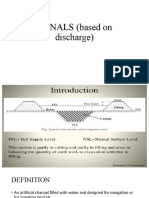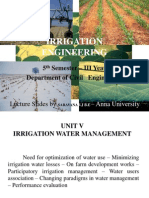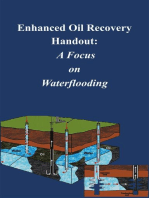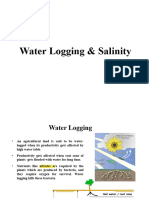0 ratings0% found this document useful (0 votes)
Canal Irrigation
Canal Irrigation
Uploaded by
mhamzayasin20024There are two main types of canals - alluvial and non-alluvial. Alluvial canals are developed through flat, plain areas with silt deposits, while non-alluvial canals pass through hard foundations. Canals can also be categorized based on their alignment - watershed, contour, or side-slope. The main components of a canal irrigation system are the main canal, branch canals, distributaries, minors, and watercourses. Water losses through canals can be significant, ranging from 25-50%, primarily through seepage and to a lesser extent, evaporation.
Copyright:
© All Rights Reserved
Available Formats
Download as PDF, TXT or read online from Scribd
Download as pdf or txt
Canal Irrigation
Canal Irrigation
Uploaded by
mhamzayasin200240 ratings0% found this document useful (0 votes)
There are two main types of canals - alluvial and non-alluvial. Alluvial canals are developed through flat, plain areas with silt deposits, while non-alluvial canals pass through hard foundations. Canals can also be categorized based on their alignment - watershed, contour, or side-slope. The main components of a canal irrigation system are the main canal, branch canals, distributaries, minors, and watercourses. Water losses through canals can be significant, ranging from 25-50%, primarily through seepage and to a lesser extent, evaporation.
Original Title
Canal irrigation
Copyright
© © All Rights Reserved
Available Formats
PDF, TXT or read online from Scribd
Share this document
Did you find this document useful?
Is this content inappropriate?
There are two main types of canals - alluvial and non-alluvial. Alluvial canals are developed through flat, plain areas with silt deposits, while non-alluvial canals pass through hard foundations. Canals can also be categorized based on their alignment - watershed, contour, or side-slope. The main components of a canal irrigation system are the main canal, branch canals, distributaries, minors, and watercourses. Water losses through canals can be significant, ranging from 25-50%, primarily through seepage and to a lesser extent, evaporation.
Copyright:
© All Rights Reserved
Available Formats
Download as PDF, TXT or read online from Scribd
Download as pdf or txt
0 ratings0% found this document useful (0 votes)
Canal Irrigation
Canal Irrigation
Uploaded by
mhamzayasin20024There are two main types of canals - alluvial and non-alluvial. Alluvial canals are developed through flat, plain areas with silt deposits, while non-alluvial canals pass through hard foundations. Canals can also be categorized based on their alignment - watershed, contour, or side-slope. The main components of a canal irrigation system are the main canal, branch canals, distributaries, minors, and watercourses. Water losses through canals can be significant, ranging from 25-50%, primarily through seepage and to a lesser extent, evaporation.
Copyright:
© All Rights Reserved
Available Formats
Download as PDF, TXT or read online from Scribd
Download as pdf or txt
You are on page 1/ 38
Canal Irrigation System
Canals are categorized as alluvial and non-alluvial canals.
• Alluvial Canals
The soil which is formed due to the transport and deposition
of silt along with water in an area over a period of time is
called alluvial soil. In the deltaic regions, a river carries
heavy charge of silt which gets deposited on the adjacent
land as and when the river overflows on the floodplains
during flooding. Such areas are flat with plain surfaces and
no hard foundations are there. The canals which are
developed through such zones are called alluvial canals.
• Non-alluvial canals
The canals passing through hard foundations and rocky
areas are called non-alluvial canals. The river passing
through such areas do not change its course.
Canal Alignment
There could be three types of canal alignments.
• Watershed or Ridge canal
• Contour canal
• Side-slope canal
Watershed or Ridge Canal
• A canal which is aligned along any natural
watershed or ridge line is called watershed
canal. It saves the cost of construction of cross
drainage works as no drain crosses a ridge
canal. These are normally developed in plain
and flat areas where land slopes are mild.
Contour Canal
• A contour canal follows a contour except for giving
the required longitudinal slope to the canal.
• A contour canal irrigates the land only on one side of
the canal because the land on the other side is at a
higher level.
• As the drainage water always flows at right angles to
natural ground contours, so the contour canal will
have to cross maximum number of drains, thus
necessitating the construction of a large number of
cross-drainage works.
• In hilly areas, watershed canal is not possible and
therefore contour canals are constructed in such areas.
Side-Slope Canal
• It is the one which is aligned at right angle to the
natural ground contours i.e. along the side slopes as
shown in the Fig. As it runs parallel to the natural
drains, so it will not encounter drains and hence will
avoid construction of cross drainage works.
Distribution System for Irrigation Canals
• A canal system is comprised of the following
1. Main Canal
2. Branch Canal
3. Distributaries
4. Minors
5. Watercourses
Gross Command Area (GCA)
• It is the total area bounded within the irrigation
boundary of a project which can be economically
irrigated without taking into account the quantity of
available water. It includes both cultivable as well as
un-cultivable areas. For example ponds, residential
areas, roads, reserved forests are the un-cultivable
parts of the gross command area.
Culturable Command Area (CCA)
• It is also termed as cultivable command area.
• It includes cultivable part of the GCA. It covers
pasture and fallow lands which can be made
cultivable.
• All of the CCA may not be cultivated at the same
time.
• It may be taken as 80% of the GCA.
Intensity of Irrigation
• The entire cultivated portion of CCA is not irrigated
at one time in a season to avoid intensive irrigation of
a particular area which might cause water logging and
salinity issues.
• The percentage of CCA proposed to be irrigated in a
particular season is called seasonal intensity of
irrigation. Sometimes it is calculated over the whole
year by adding the crops to be irrigated in the entire
year and termed as annual intensity of irrigation.
Net and Gross Sown Areas
• The area which is sown only once in a particular year
is termed as net sown area.
• If the area sown more than once in a year is added up
in net sown area, then the total area obtained is
termed as gross sown area.
Net and Gross Irrigated Areas
• The area which is irrigated during one season in a
particular year is termed as net irrigated area.
• If the area irrigated more than once in a year is added
up in net irrigated area, then the total area obtained is
termed as gross irrigated area.
Area to be irrigated & Time Factor
• Area to be irrigated in one particular season/year and
is obtained by multiplying CCA by seasonal/annual
intensity of irrigation.
• The ratio of actual operating period of a distributary
to the crop period is termed as time factor of the
distributary. It is less than one. It is to avoid over-
irrigation and thus to prevent water logging and
salinity.
Capacity Factor
• Capacity factor of a canal is the ratio of mean supply
discharge in a canal during a particular season/period to
its designed full capacity.
• The capacity factor is 0.9 to 0.95 for Kharif (summer )
season because canals run to almost their full designed
capacities during hot summer season and it is 0.6 to 0.7
for Rabi(winter) season because water demand reduces to
2/3rd of the full capacity during winter. The cropped area
in Rabi is thus increased to enhance capacity factor
Full Supply Coefficient:
• It is the design duty at the head of the canal. i.e. the
number of hectares irrigable per cumec of the canal
capacity at its head is called full supply coefficient.
FSC= [Area estimated to be irrigated during base period
/design full supply discharge at canal head]
Water Losses in Canal
• The water losses through canals could be as high as from 25 to
50%. It includes both evaporation and seepage losses through
the canal periphery.
• Evaporation Losses
These losses are very small as compared to seepage losses and
normally range up to 2 to 3% of the total losses. These depends
upon temperature, wind velocity, humidity. In summer these
losses might go up to 7% of the total inflow.
• Seepage Losses
These could be percolation losses and absorption losses.
In percolation, there exists a zone of continuous saturation from
the canal to the water table and a direct flow is established. The
entire water lost from the canal joins the groundwater storage.
The water loss depends upon head difference b/w canal water and
groundwater.
Absorption:
In it a small saturated zone
exists around the canal
section and is surrounded
by the zone of decreasing
saturation. The zone just
above the water table is
saturated by capillarity.
The rate of seepage loss is
independent of seepage
head H but depends only
upon the water head h i.e.
the distance b/w water
surface level of canal and
bottom of saturation zone
plus the capillary head hc.
Factors Affecting Seepage Losses
• Type of seepage i.e. whether percolation or
absorption
• Soil permeability
• Canal condition as seepage through a silted canal will
be less than that of an un-silted canal
• Water velocity in the canal more the velocity less will
be losses.
• Silt carried by the canal, more the silt less will be
losses
• Canal cross-section and its wetted perimeter
You might also like
- Lecture Series 15 - Canal Irrigation SystemNo ratings yetLecture Series 15 - Canal Irrigation System40 pages
- Canal Irrigation System: Chapter No 03 by Santosh Kumar GargNo ratings yetCanal Irrigation System: Chapter No 03 by Santosh Kumar Garg61 pages
- Irrigationchannelsnxpowerlite 120722084223 Phpapp01100% (1)Irrigationchannelsnxpowerlite 120722084223 Phpapp0188 pages
- Irrigationchannelsnxpowerlite 150327075134 Conversion Gate01No ratings yetIrrigationchannelsnxpowerlite 150327075134 Conversion Gate0188 pages
- CM & CD Works and Design of LI Schemes PDFNo ratings yetCM & CD Works and Design of LI Schemes PDF46 pages
- Quantity of Wastewater Sanitary EngineeringNo ratings yetQuantity of Wastewater Sanitary Engineering7 pages
- Reservoir, It's Purposes, Classification of ReservoirNo ratings yetReservoir, It's Purposes, Classification of Reservoir19 pages
- 06a. Classification of Canals & Lining (WoN)No ratings yet06a. Classification of Canals & Lining (WoN)38 pages
- Layout of Reservoir, Diversion Structures and Other StructuresNo ratings yetLayout of Reservoir, Diversion Structures and Other Structures36 pages
- Intake diversion Structures _ 11 Mar 13No ratings yetIntake diversion Structures _ 11 Mar 1336 pages
- The Decline and Fall of The Roman Empire, Volume II The Decline and Fall of The Roman Empire, Volume II The Decline and Fall of The Roman Empire, Volu (PDFDrive)No ratings yetThe Decline and Fall of The Roman Empire, Volume II The Decline and Fall of The Roman Empire, Volume II The Decline and Fall of The Roman Empire, Volu (PDFDrive)977 pages
- Relationship Between Drug Use and Criminal Behavior.No ratings yetRelationship Between Drug Use and Criminal Behavior.2 pages
- Mengurangi - Kerentanan - Ekosistem - Di - Teluk - Bungus - 11 - Des - 2013No ratings yetMengurangi - Kerentanan - Ekosistem - Di - Teluk - Bungus - 11 - Des - 201373 pages
- Geolandscapes and Geotourism: Integrating Nature and Culture in The Bucegi Mountains of RomaniaNo ratings yetGeolandscapes and Geotourism: Integrating Nature and Culture in The Bucegi Mountains of Romania26 pages
- Quest Campus Larkana Department of Civil EngineeringNo ratings yetQuest Campus Larkana Department of Civil Engineering6 pages
- Indian River Systems: For Different Government ExamsNo ratings yetIndian River Systems: For Different Government Exams13 pages
- Exercises Names With and Without the-WPS OfficeNo ratings yetExercises Names With and Without the-WPS Office2 pages
- 2305 - 15 - Hasil Trial Embankment FilterNo ratings yet2305 - 15 - Hasil Trial Embankment Filter12 pages
- Technical Talk On Msma 2 Edition Using Mes SoftwareNo ratings yetTechnical Talk On Msma 2 Edition Using Mes Software28 pages
- 1923 Memoir On Maps of Chinese Turkistan by Stein SNo ratings yet1923 Memoir On Maps of Chinese Turkistan by Stein S252 pages
- An Analytical Method For Predicting The Groundwater Inflow To Tunnels in A Fractured Aquifer s10040-022-02485-6No ratings yetAn Analytical Method For Predicting The Groundwater Inflow To Tunnels in A Fractured Aquifer s10040-022-02485-615 pages
- Book Conference Foundation in Difficult Subsoil ConditionsNo ratings yetBook Conference Foundation in Difficult Subsoil Conditions144 pages
- Hydrographs: Prepared By: Engr. Neslyn E. LopezNo ratings yetHydrographs: Prepared By: Engr. Neslyn E. Lopez10 pages
- Physical & Political Divisions of The WorldNo ratings yetPhysical & Political Divisions of The World30 pages
- Canal Irrigation System: Chapter No 03 by Santosh Kumar GargCanal Irrigation System: Chapter No 03 by Santosh Kumar Garg
- Irrigationchannelsnxpowerlite 120722084223 Phpapp01Irrigationchannelsnxpowerlite 120722084223 Phpapp01
- Irrigationchannelsnxpowerlite 150327075134 Conversion Gate01Irrigationchannelsnxpowerlite 150327075134 Conversion Gate01
- Reservoir, It's Purposes, Classification of ReservoirReservoir, It's Purposes, Classification of Reservoir
- Layout of Reservoir, Diversion Structures and Other StructuresLayout of Reservoir, Diversion Structures and Other Structures
- Enhanced Oil Recovery Handout: A Focus on WaterfloodingFrom EverandEnhanced Oil Recovery Handout: A Focus on Waterflooding
- The Decline and Fall of The Roman Empire, Volume II The Decline and Fall of The Roman Empire, Volume II The Decline and Fall of The Roman Empire, Volu (PDFDrive)The Decline and Fall of The Roman Empire, Volume II The Decline and Fall of The Roman Empire, Volume II The Decline and Fall of The Roman Empire, Volu (PDFDrive)
- Relationship Between Drug Use and Criminal Behavior.Relationship Between Drug Use and Criminal Behavior.
- Mengurangi - Kerentanan - Ekosistem - Di - Teluk - Bungus - 11 - Des - 2013Mengurangi - Kerentanan - Ekosistem - Di - Teluk - Bungus - 11 - Des - 2013
- Geolandscapes and Geotourism: Integrating Nature and Culture in The Bucegi Mountains of RomaniaGeolandscapes and Geotourism: Integrating Nature and Culture in The Bucegi Mountains of Romania
- Quest Campus Larkana Department of Civil EngineeringQuest Campus Larkana Department of Civil Engineering
- Indian River Systems: For Different Government ExamsIndian River Systems: For Different Government Exams
- Technical Talk On Msma 2 Edition Using Mes SoftwareTechnical Talk On Msma 2 Edition Using Mes Software
- 1923 Memoir On Maps of Chinese Turkistan by Stein S1923 Memoir On Maps of Chinese Turkistan by Stein S
- An Analytical Method For Predicting The Groundwater Inflow To Tunnels in A Fractured Aquifer s10040-022-02485-6An Analytical Method For Predicting The Groundwater Inflow To Tunnels in A Fractured Aquifer s10040-022-02485-6
- Book Conference Foundation in Difficult Subsoil ConditionsBook Conference Foundation in Difficult Subsoil Conditions

































































































